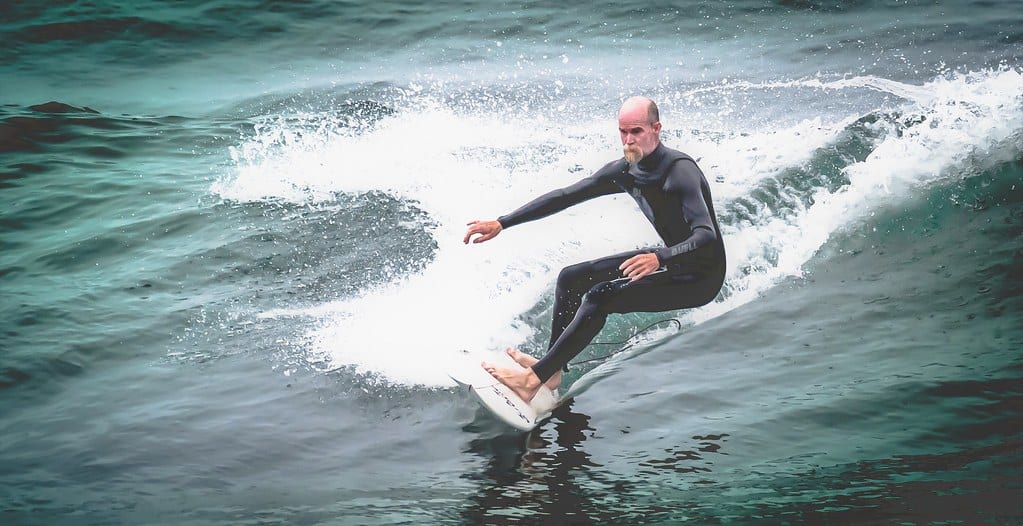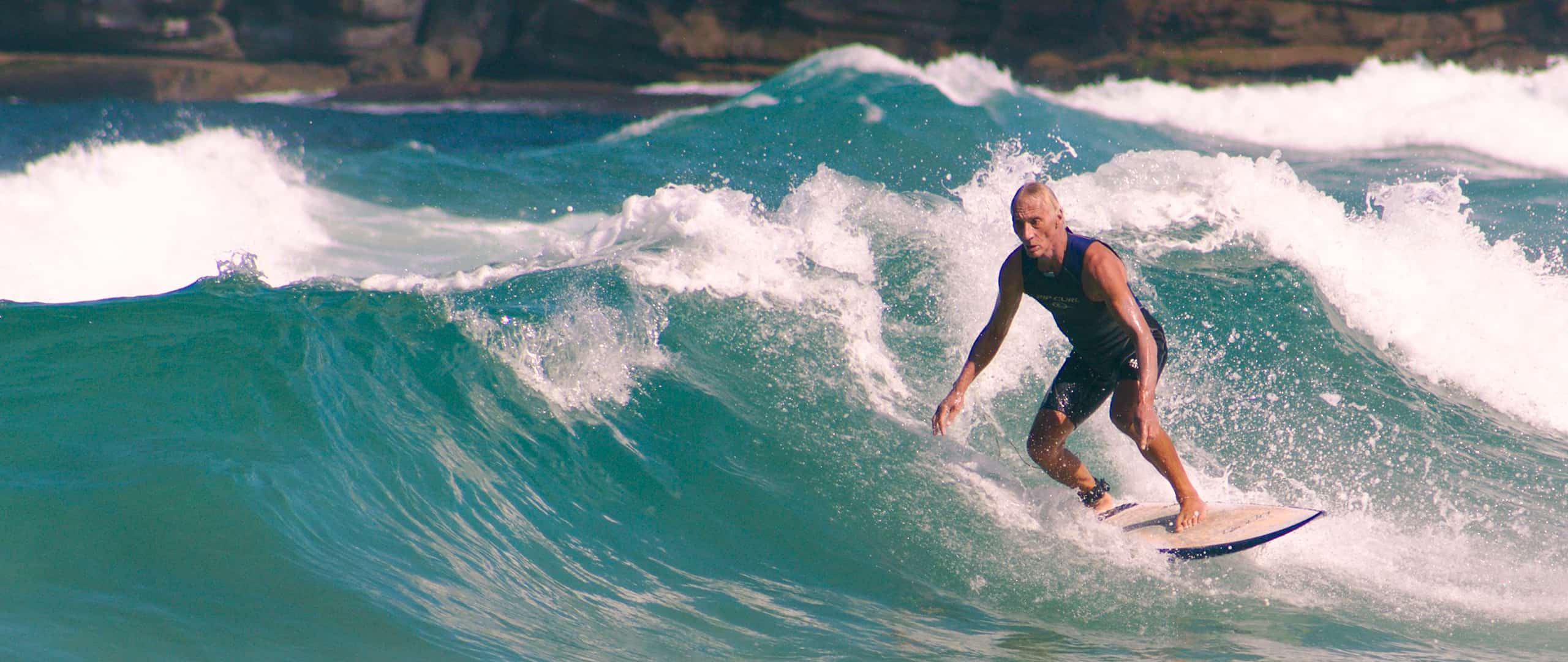Surfing is an idyllic way to spend your time. It’s a fun and relaxing sport that helps you get fit and brings excitement to your life. Many people want to to surf but are worried that their window to learn has already passed.
Can you learn to surf at any age? Yes, with the right training and patience, you can learn to surf at any age! Let’s take a look at the benefits of learning to surf later in life, how to learn to surf, and what it’s like to learn to surf later in life.
The Benefits of Learning to Surf – Regardless of Your Age!
There are endless benefits to surfing, and none of them diminish as you age! Four main benefits of surfing stand out to me: spending time exercising, with your thought, outside, and with others!
We all know it’s a good idea to get exercise. It’s recommended to exercise for thirty minutes, five times a week. Surfing is a great full body exercise that gives you a great cardio and cardiovascular workout. It can help keep you strong, happy and healthy!
Surfing also gives you the chance to simply spend time with your thoughts. In our crazy, fast paced world, it’s easy to get swept up in all that’s happening and forget to hit pause for a moment. Sure, surfing can be an adrenaline-pumping sport, but it also includes spending a chunk of your time sitting on your board, waiting for a wave to come. During this time, there’s not much to do but sit, relax, think, and look at the beautiful ocean around you. In other words, surfing gives you the chance to just stop and think.
Surfing also gives you the chance to spend time outside. Countless studies have found that spending time outside has massive positive effects on our health and wellbeing. For example, spending time outside decreases stress, anxiety and irritability, increases feelings of calm and happiness, and improves concentration.
Surfing is also great for interpersonal connections. Not only is it fun to go surfing with friends, it’s actually very important for your safety as well. Spending time in the water with buddies gives you the chance to reconnect and chat… without any smartphones around!
Regardless of your age, if you are seventy years old or eight years old, you can still enjoy these benefits by going surfing. It’s never too late to learn how to surf!

What It’s Like to Learn to Surf Later in Life
Let’s be honest, sometimes being a beginner sucks. Going back to the basics and struggling to learn a new skill can be frustrating and humbling. That being said, learning something new later in life can also be an extremely liberating and eye opening experience.
Many people who learned to surf later in life expressed that it helped them get out of their usual routine expand their horizons, They also reported that learning to surf later in life made them feel younger and revitalized their spontaneous and playful side! One surfer even reported that learning to surf later in life was one of the best decisions she ever made. She said it renewed her sense of adventure and gave her a new challenge and past time she could look forward to every day.
As the saying goes, if not today, then when? There’s no better day than today to get started on this new chapter in your life. Why not go for it!
How to Learn to Surf
Regardless of your age, it’s always a good idea to check in with your doctor to get their stamp of approval before starting a new exercise or sport. This is particularly relevant if you are a senior citizen or have pre-existing injuries or health conditions.
Once you have your doctor’s go ahead, it’s good to check in on your general fitness before hopping straight on a surfboard. Surfing is a great full body workout that requires a decent level of fitness, flexibility and balance. Before hopping on a surfboard, make sure your fitness is up to par by going on light jogs, swimming, doing yoga, playing sports, lifting weights, or another exercise of your choice. As previously mentioned, it is a general rule of thumb that working out thirty minutes a day, five days a week is good for your health and fitness. That being said, if you haven’t worked out in months, it’s probably not a good idea to immediately start working out five days a week at full exertion level. Start slow, work up, and listen to your body.
Moreover, be sure to tailor your workouts to your age. As you age, it is important to practice low-impact sports and exercises. A low impact exercise is an exercise where at least one of your feet always stays on the ground. This helps protect your body, particularly your joints. Some low impact exercises include swimming, walking, yoga, barre, water aerobics, or biking.
Stretching is also incredibly important. Stretching prevents injury. As you age, you loose flexibility, which makes you more susceptible for muscular injury. Be sure to stretch before and after every workout.
It is also incredibly important to assess your current ability to balance and improve your balance skills if needed. This is particularly important if you are older or have more fragile bones and joints. When you are surfing, you need to be able to balance on your board. The better you are able to balance, the longer you will be able to stand on your board to ride a wave, and the less likely you are to have a potentially damaging fall off of your board.
Moreover, before learning to surf, you should first ensure you are a confident open ocean water swimmer. If you are not a confident ocean swimmer, it can be very dangerous to surf. Surfing requires your strong ability to swim to and from shore to a safe surf spot, swim in rough water, swim against or with currents, and successfully swim to the surface of the ocean when a wave pulls you underwater. You should be comfortable swimming at least 200 consecutive meters in still water before attempting to surf in the open ocean.
Now that you’ve received a go-ahead from your doctor and have assessed your fitness and strength as an open ocean water swimmer, it’s time to get surfing! I highly recommend surfing with an experienced surfer for your first few times in the ocean. If you have friends or family who are experienced surfers, ask them to show you the ropes. If not, take a beginners surf lesson. Most major surf spots have surf schools where you can sign up for a private or group lesson.
It is important to learn to surf with an experienced surfer so that you can learn the proper form and technique. Surfing, as with most sports, is all about muscle memory. If you start off with the wrong techniques, it will be very difficult to change your habits later to become a better surfer.
It is also important to learn with an experienced surfer because an experienced surfer will help you assess the water and waves and choose the correct waves to surf. It may be difficult for you to know when to start paddling or when to stand up on your surfboard. Having an instructor there to help will expedite your learning curve and help you catch some waves!
Lastly, it is also important to learn with an experienced surfer for safety reasons. As a beginner, you are more susceptible to injuries or accidents. It is good to have an experienced surfer with you to keep an eye out for your safety and help you should you need a hand.
Learning to surf is a great pastime and one you won’t regret! Be safe, have fun and get learning!
Related Questions
What is the Best Surf Board for a Beginner?
Generally speaking, the bigger the board, the better it is for beginners. The best boards for beginner surfers are funboards or longboards. A funboard is a surfboard that is six to eight feet long (pretty big!) and is wider than an average board. The large surface area on a funboard allows beginner surfers to practice finding the right stance. A longboard is similar to a funboard, but it is even longer and usually thicker (has extra foam). A longboard is a floatier and slower ride than other surfboards, and allows riders (beginner or experts) to move forward and backward on the board once standing.
Where is the Best Place to Learn To Surf?
There are many great places to surf. When you are looking for a beginner surf spot, you should look for slow, rolling waves. Arguably one of the best places to surf is Waikiki in Hawaii. Waikiki is one of the most popular beaches in the entire world. Tourists travel from near and far to visit the beautiful sandy beach, dine on fresh seafood, shop at beachside boutiques, and surf! It is the perfect place to surf for beginners due to its gentile, consistent, slow rolling waves.
How Much Do Surf Lessons Usually Cost?
There is a wide price range for surf lessons. You can usually choose from group or private surf lessons. Private lessons are more expensive. Private surf lessons in the US usually cost somewhere between 20 – 150$ for a two hour session.
Is There Protective Padding I can Wear While I Learn To Surf to Avoid Injuries?
There is! Wearing protective padding is a great idea for beginner surfers who are senior citizens or who have preexisting injuries or health conditions. First and foremost, if you wear braces (ankle braces, knee braces, shoulder braces, etc.) when you practice other sports, you should continue to wear these braces when you surf. As for padding, there are typically two protective padding items offered for surfers. The first is a vest. These vests pad the area where surfers’ ribs press against their surfboards while paddling and provide comfort for surfers who experience rib pain. The second common protective padding surfers wear are knee pads. These knee pads protect your knees from slamming on the hard board while you are standing up to catch a wave or when you fall from standing.
Are There Social Groups for Senior Citizen Surfers?
Yes, there are groups for senior citizen surfers! To find a group of surf friends who are also in their golden years, you can search Facebook or Meetup. Simply go to each of these free websites and type into the search bar your location and what you’re looking for. For example, “Waikiki, Senior Citizen Surf Group”. Hopefully you’ll find some likeminded individuals who you can learn, surf and have fun with!


